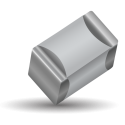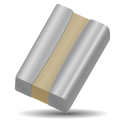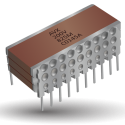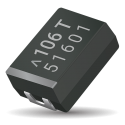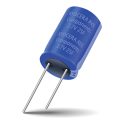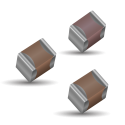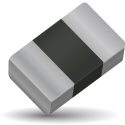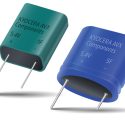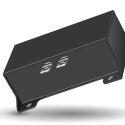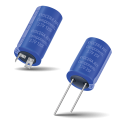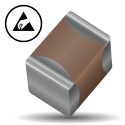These small, high-CV MLCCs enable revolutionary board space, weight, and component count reductions in high-reliability military applications. FOUNTAIN INN, S.C. (February 15, 2023) – KYOCERA AVX, a leading global manufacturer of advanced electronic components engineered to accelerate technological innovation and build a better future, is proud to announce that its MIL-PRF-32535 BME NP0 MLCCs have been approved to the Defense Logistics Agency (DLA) Qualified Products Database (QPD). The new MIL-PRF-32535 BME NP0 MLCCs have higher CV capabilities than standard surface-mount PME MLCCs qualified to military and aerospace specifications and are currently available in “M” and “T” reliability levels and 0402, 0603, and 0805 case sizes and rated for 68–1,500pF and 4–100V. These small, high-CV MLCCs enable revolutionary board space, weight,
News / Events / Press
Low Inductance Capacitors for High-Speed Decoupling Written By: Robert Lu Abstract: Modern integrated circuits (IC’s) consume power at rapidly varying rates due to the density of circuits on-board and the extreme speed at which they can operate. Power supplies are required to respond to these changes in load current while maintaining a constant operating voltage. This task is becoming increasingly difficult as the complexity of power distribution networks grows and printed circuit board (PCB) design requires optimization for parasitic inductance and capacitance. Therefore, any power supply performance slack must be absorbed by the all-too-common decoupling capacitor. As shown in Figure 1, a decoupling capacitor is simply an additional parallel capacitance that provides a stable voltage and source of current when
The new online tool and global design support service will help customers quickly and confidently select crystal timing devices optimized for their ICs. FOUNTAIN INN, S.C. (February 13, 2023) – KYOCERA AVX, a leading global manufacturer of advanced electronic components engineered to accelerate technological innovation and build a better future, has introduced a new circuit matching service designed to help customers quickly and confidently select suitable crystal timing devices. When oscillator circuits aren’t optimized for customers’ ICs or timing devices, it can result in abnormal oscillation or even prevent oscillation, which could lead to device failure. The new online circuit matching service identifies KYOCERA AVX crystal timing devices recommended by leading global IC manufacturers to ensure that customers choose compatible
MIL-PRF-32535 for discrete MLCCs has led to the discussion of stacked ceramic capacitors based on BME technology. Stacked ceramic capacitors are multiple discrete multi-layer ceramic capacitors (MLCCs) terminated onto a common lead-frame for through-hole or SMT operations. They capture many of the inherent benefits of MLCC technology, like a low-loss material set, low ESR (equivalent series resistance), and higher reliability. Typical applications like switch mode power supplies need larger capacitance values and current capabilities. Stacked MLCCs compete with discrete electrolytic capacitor technology in terms of capacitance range but have an advantage in terms of voltage and temperature capability, which naturally increases their reliability, thereby making this a preferred technology for defense applications despite its higher price point compared to electrolytics.
Polymer Solid Electrolytic Capacitors for Automotive Applications Written By: Jaroslav Tomasko | Slavomir Pala Abstract: Tantalum electrolytic capacitors are constructed using a sintered pellet of powdered tantalum as the anode of the device. A grown oxide layer on the contoured surface of the pellet acts as the dielectric insulator, and a cathode terminal is formed using either a conventional MnO2 electrolyte or a conductive polymer to sufficiently contact the oxide layer. The final capacitor can be packaged in many forms, and the typical J-lead surface mount construction is shown in Figure 2. The capacitive structure is bonded to a molded case and electrically interfaced using carbon as a separation layer and silver for connection with the lead frame.
Five field-proven SCC Series supercapacitors are now tested and qualified to the stringent AEC-Q200 standard, proving their ability to reliably withstand the challenging mechanical and electrical conditions common in automotive applications. FOUNTAIN INN, S.C. (February 2, 2023) – KYOCERA AVX, a leading global manufacturer of advanced electronic components engineered to accelerate technological innovation and build a better future, is proud to announce its first automotive-qualified supercapacitors, which are also known as cylindrical, electrochemical, double-layer capacitors. The five new automotive-qualified SCC Series supercapacitors are tested and qualified to the stringent AEC-Q200 standard, which proves their ability to reliably withstand test conditions designed to replicate challenging mechanical and electrical conditions common in automotive applications. SCC Series supercapacitors have a ruggedly constructed form
Analysis of the DC Blocking Capacitor for Stereo High-Fidelity Audio Written By: Rick Liu Abstract: The representation of audio signals in analog and digital electronics can take many forms. Still, they must ultimately be converted back to their mechanical origins as the motion of air molecules propagating as waves. These waves are generated by moving a mass, often the cone of a speaker, back and forth around a neutral position. As such, any fixed offset in the audio signal, represented by a DC bias, is simply a waste of energy and possibly a source of imbalance in the resulting sound wave. Series blocking capacitors are generally used for each audio channel to eliminate the potential of any DC component. While
Variability and Tolerance of Ceramic Capacitors Written By: Robert Lu Abstract: The multi-layer ceramic capacitor (MLCC) is one of the most common capacitor varieties found in electronic design. It offers a wide range of bulk capacitance and voltage tolerance in numerous form factors at relatively low cost. While these devices have become commonplace in the designers’ tool chest, they exhibit some often overlooked peculiarities. Of primary concern is the sensitivity of effective capacitance to several environmental factors, including temperature, applied bias voltage, and age. If these factors are unaccounted for, the risk of product failure becomes very real, especially in manufacturing variability and overall tolerance stack-up.
Platform Structure Clock Oscillators Written By: Toshihiko Koyanagi Abstract: Numerous devices in people‘s lives today are becoming more sophisticated. As a result, the number of crystal devices installed is increasing. For example, with the evolution of autonomous driving, we are using crystal devices for many functions such as sensor systems to detect distance, camera systems to capture images, image processing systems to process captured images, and communication systems to communicate many of those digital data in and out of the vehicle at high speed. In addition, in the network market, the number of crystal devices is increasing along with the further increase in the speed of communication devices, as well as the increase in the frequency and precision. This paper
A growing number of applications, ranging from solar power converters all the way to miniature power supplies for highly complex processing cores, are starting to capitalize on the benefits of aluminum electrolytic capacitors. Aluminum electrolytics are also increasingly used to satisfy miniaturization demands in complex power tree applications like FPGAs powered by multiple voltages. And while it’s true that aluminum electrolytics also come with disadvantages, several of the more well-known ones are no longer true, and other perceived disadvantages can be reduced or eliminated by selecting newer components engineered to overcome some of the technology’s traditional shortcomings. Power Systems Design (PSD) December 22nd 2022
NEW | Multilayer Varistors Qualified to OPEN Alliance Standards for Automotive Ethernet Applications
As an OPEN Alliance member, KYOCERA AVX has extended its proven, high-performance, and ultralow-capacitance AntennaGuard range with the addition of two new MLVs that meet IEEE 1000BASE-T1 and 100BASE-T1 testing requirements, significantly outperform competing diode solutions, and deliver exceptional reliability in space-saving 0402 and 0603 packages. FOUNTAIN INN, S.C. (January 10, 2022) – KYOCERA AVX, a leading global manufacturer of advanced electronic components engineered to accelerate technological innovation and build a better future, has extended its AntennaGuard range of proven, high-performance, and ultralow-capacitance products with two new 0402 multilayer varistors (MLVs) that meet IEEE 100BASE-T1 and 1000BASE-T1 testing requirements. The new ASPGuard® Series MLVs have small, ultralow-profile, surface-mount packages optimized for high-density designs and exhibit high current and energy handling
CES 2023 marks KYOCERA AVX’s first year of participation at this legendary industry event. Exhibit highlights include advanced antenna and RF component solutions for IoT, 5G, healthcare, consumer electronics, and satellite communications applications as well as advanced sensor and control solutions for electromobility applications. FOUNTAIN INN, S.C. (January 3, 2023) – KYOCERA AVX, a leading global manufacturer of advanced electronic components engineered to accelerate technological innovation and build a better future, is exhibiting at CES 2023, which will take place Thursday, January 5, through Sunday, January 8, in Las Vegas. CES has earned a reputation as a proving ground for breakthrough technologies and global innovators and is widely recognized as one of the most influential tech events in the world.
SuperCapacitor Improvements on Small Generator Power Quality Written By: Ron Demcko | Ashley Stanziola | Daniel West Abstract: To expand portable electronics usage/reach/offering, the renewable power industry has taken an interest in the worldwide awareness of climate change and electronic waste, specifically how batteries affect the environment. One advancement is the emergence of modern low power hand crank generators, which roughly coincides with the accelerating interest in green energy used in portable electronics.
Predicting Metal Film Capacitor Lifetime Using Thermal Simulation Written By: Youssef Laamimat Abstract: In high-power applications like electric vehicles (EVs), customized metal film capacitors are often required to meet energy demands in a specific form factor. These capacitors exhibit a strong temperature dependence of their bulk capacitance over time, which directly limits their total service life. To maximize lifetime while minimizing space requirements, it is important to include accurate thermal simulation as part of the design process to ensure optimized and evenly distributed heat generation.
SuperCapacitors: A Reliable Backup Power Solution Written By: Johnson Jiang Abstract: Electric double-layer capacitors (EDLCs) are electrochemical capacitors called “SuperCapacitors,” or supercaps, due to their high energy density. Compared to traditional electrolytic capacitors, SuperCapacitors store electrical energy about two to three orders of magnitude higher and achieve several hundred thousand to millions of charge-discharge cycles. This advantage comes from the special construction of SuperCapacitors.
Electrostatic Protection Using Ceramic Capacitors Written By: Oliver Zimmermann | John McCarry Abstract: Any conductive interface between an electrical circuit and the outside world introduces the possibility of damage through electrostatic discharge (ESD). Accumulated static charge on a person, a cable, or any similar surface can readily dissipate its stored potential energy upon contact into sensitive components resulting in highly destructive currents. Ideally, varistors and TVS diodes only activate to protect the circuit when a high voltage is present and impart no parasitic effects during normal operation. For high-speed data lines, in particular, it is critical that the protection device introduce as little capacitance as possible (Electronic Design). TVS diodes and varistors are therefore specified not only by their voltage
